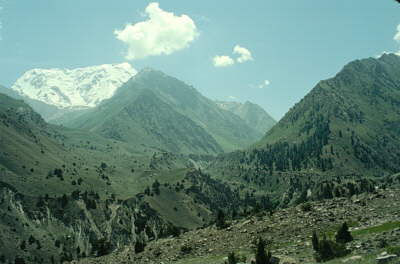Structural Geology of the Southwestern Margin of
Nanga
Parbat
 M.
A. Edwards, W.
S. F. Kidd, (both at: Dept
of Earth and Atmospheric Sciences, University at Albany, Albany, NY
12222
M.
A. Edwards, W.
S. F. Kidd, (both at: Dept
of Earth and Atmospheric Sciences, University at Albany, Albany, NY
12222
M. Asif Khan (Peshawar University, Pakistan)
D. A. Schneider, P. K. Zeitler, D. Anastasio, (all at: Dept
of Earth and Environmental Sciences, Lehigh University, Bethlehem,
PA 18015, USA).
EOS, Trans. Amer. Geophys. Union, 78, F651. Presented as
poster
session, 9th December, 1997 Fall Meeting, American Geophysical Union,
San
Francisco.
Abstract
The Main Mantle Thrust (MMT) is the regional contact between
collider
India and the overthrust Kohistan-Ladakh series in the Pakistan
Himalaya.
Early Himalayan-age thrusting and some later (~20 Ma?) normal motion
on/near
the MMT is modified by very young (e.g. 1.4 Ma leucogranite Th-Pb ages)
tectonism at Nanga Parbat-Haramosh Massif (NPHM); the Himalaya's
western
syntaxis. Our investigations in southwestern NPHM reveal a complex
interplay
of MMT-related (mostly convergent) structural features followed by
those
related to uplift and tectonism of NPHM. Across the Diamir/Bunar area,
main fabrics trend N to NE. In Diamir Valley, Indian cover passive
margin
metapelites and carbonates in the MMT footwall are not more than a few
100’s of metres thick. Here, the regionally NW-dipping Indian cover
sequences
and MMT hanging wall (Kamila amphibolite) are overturned (SE-dipping).
These overturned layers are traceable to the Gashit fold, whose hinge
line
plunges ~N and axial surface dips gently-moderately east. The cover
sequence
thickness increases markedly to the south; several km structural
thickness
of carbonates, metapelites and amphibolites are present in the W-E
Airl-Nashkin
section, only 8 km to the south of Diamir valley. The cover sequence
passes
east into a dominantly plutonic 5-10 km thick crystalline sequence
where
coarse to fine grained granite (the Jalhari granite) grades, due to
syn-
to post-plutonism deformation, into granitic and porphyroclastic gneiss
intercalated with gneissic basement. Regionally the cover and
crystalline
rocks follow the subvertical to steeply E-ESE dipping foliation, and
displacement
sense is consistently east side (NPHM) up and over west. Within Diamir
valley, granitic and gneissic foliation, shear bands, and local fault
gouge
zones anastamose around less- to un-deformed Jalhari granite lenses of
10-100’s metres width. Plutonism seems to be in part synkinematic, and
may provide an older age limit for NPHM tectonism. The E over W sense
is
consistent with the development of the Gashit fold and the upper limb
that
includes the overturned cover/MMT layers. The sharp attenuation of the
cover sequence in northern Bunar valley could be a result of excision
by
normal motion along the MMT but we find no compelling evidence for
this.
We propose that the attenuation is a result of (1) a large frontal ramp
in the MMT and an underlying related duplex largely of Indian cover
and/or
(2) original MMT thrust belt morphology where a lateral ramp-related
duplex
system has imbricated (and/or infolded) local thin slices of the cover
and basement.
Poster
Fig. 1. Regional geological setting of
the
Nanga Parbat-Haramosh massif [NPHM]
Fig. 2. Outline geological map of the
Nanga
Parbat-Haramosh Massif
Fig. 2a. Geological map of the
southwestern
margin of the Nanga Parbat Massif
Fig 3. Geological cross-sections of the
Diamir
Gah and Nashkin-Airl Gah profiles
Fig 4. Geological cross-section of
southern
Nanga Parbat massif
Fig 5. Cartoon structure sections prior
to
Nanga Parbat massif exhumation
Summary captions and access to photos
Acknowledgements: We thank Chris Coath at UCLA for help with
ion microprobe analyses.
This poster is dedicated to the memory of Aslam Mohummad, our great
friend
and logistics-wizard in Pakistan. He died suddenly and unexpectedly in
September 1997.
1996 AGU abstract
Contribution to the Nanga
Parbat project, funded by the National
Science Foundation Continental Dynamics Program.
Return to
Bill
Kidd's page
 M.
A. Edwards, W.
S. F. Kidd, (both at: Dept
of Earth and Atmospheric Sciences, University at Albany, Albany, NY
12222
M.
A. Edwards, W.
S. F. Kidd, (both at: Dept
of Earth and Atmospheric Sciences, University at Albany, Albany, NY
12222